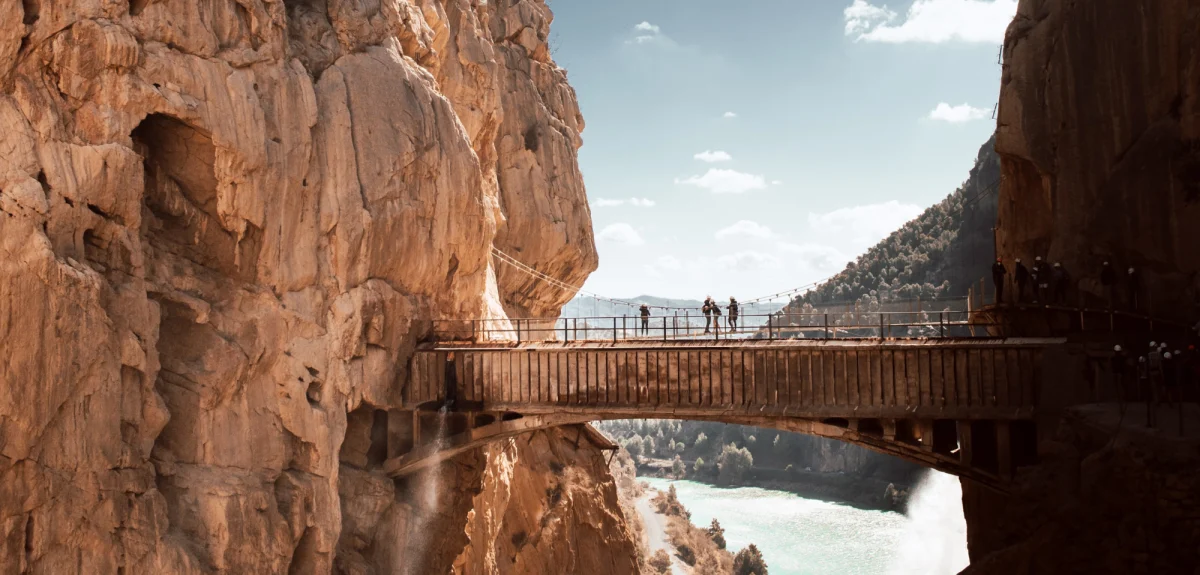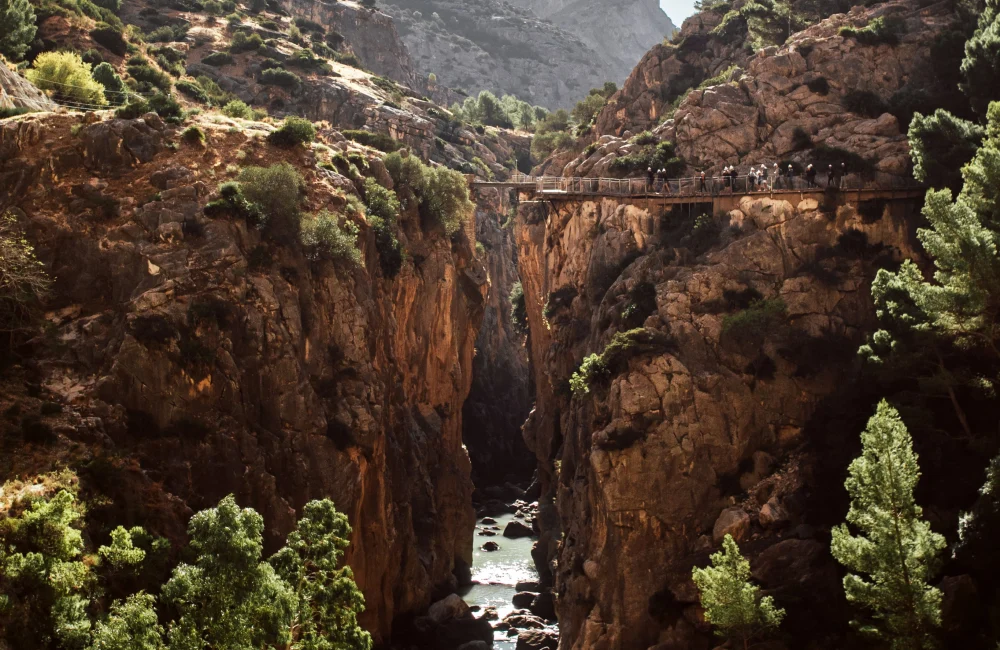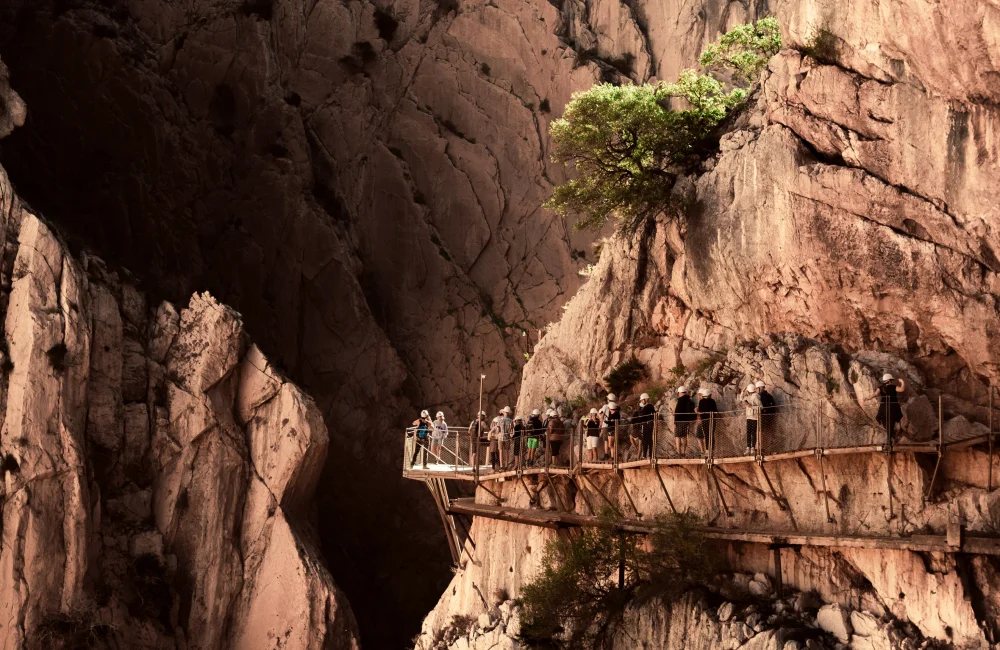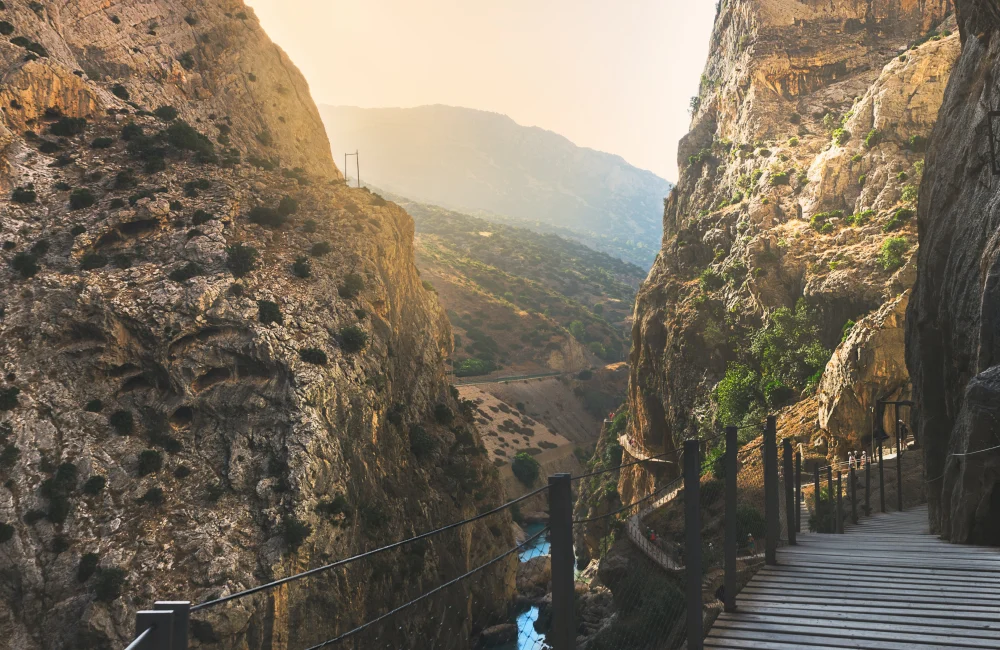
Caminito del Rey – the Most Dangerous, but Safe hiking trail in the world
In the mountains overlooking the Mediterranean, awaits a dramatic landscape and a unique adventure.
There are places that, over time, develop a life of their own. The mythology they give birth to grows, and just being able to say “I’ve been there” can be enough to pique people’s interest. At over 100 years old, the Caminito del Reyhiking trail that runs through the Desfiladero de los Gaitanes ravine in southern Spain is one such place.
With narrow platforms in catastrophically poor condition, having neither handrails nor fences and being at a high altitude, it has long been known as “the most dangerous hiking trail in the world”.
However, following a complete renovation of the 7.7 kilometre long route, this name could now be changed to “the most dangerous, but safe hiking trail in the world”.

Just above the half-crumbled old road now hang several kilometres of modern and easily accessible platforms made from steel and wood. Thanks to these platforms, the unique natural environment of the Caminito del Reycan be easily enjoyed by everyone, not just adrenaline junkies looking for adventure. What the renovation and improved level of safety have not changed is the incredible feeling of hiking at an altitude of more than 100 metres above a steep ravine, surrounded by a dramatic mountain landscape.
In addition, the fact that the trail is located less than an hour away from the beaches of Malaga makes it a perfect excursion destination during any trip to the Costa del Sol.
Despite its proximity to the coast, the mountainous interior feels like a completely different world. After passing through row upon row of orange groves, the road starts to climb and the mountains draw ever more into view. The landscape becomes barren and the road increasingly winding before it suddenly opens up on a lush pine forest running along Embalse Conde de Guadalhorce, a large artificial lake that marks the starting point of Caminito del Rey.

At the El Miradorrestaurant, which overlooks the lake, visitors take the opportunity to fuel up on freshly-squeezed orange juice from the groves they passed on the way before emarking on their hike. The air feels incredibly fresh and pure, which is confirmed by the area being designated as one of the best places in Europe for making looking at the stars.
If at all possible, the sky seems to be more blue than down by the coast. However, the Caminito del Reybegins in almost total darkness thanks to a 150 metre-long tunnel that cuts straight through the mountain. Upon exiting the tunnel, walkers are greeted by huge rock walls with geological formations and caves that were used as homes by farmers well into the 20th Century.
This is just the beginning of the natural spectacle that hides behind the control station where helmets are issued. After a short walk, it is not long before the solid ground under your feet turns into platforms that cling high along the walls of the steep ravine.
The enormous proportions of the mountain make the platforms look like they are built of matchsticks, winding up and down like an infinite balcony along the cliff face.
The Guadalhorceriver, which has slowly but surely carved the ravine from the mountain, flows far below. At the narrowest point of the ravine, the river disappears from sight, the only indication of its existance being the constant roar of the water. In other places, where the river is wider, the waters illuminate the bottom of the ravine, alternating between emerald green and brown.
Surrounded by this fascinating landscape, it’s easy to forget where you really are, namely a narrow platform suspended from a mountain and walking on wooden planks that are only 5 centimetres thick. But the even surface and solid fence mean that even a novice adventurer can fully enjoy this landscape of vertical drops and the strange limestone formations - despite being in surroundings that demand respect.
The Caminito del Rey is actually several hiking trails in one. After the dizzying start in the ravine, the trail transitions to a wide climb in the shadow of fragrant pine trees through the large Valle del Hoyovalley. The path is dusty and the dry stones crunch under your feet. The Andalusian sun is warming and it is difficult to imagine that this arid landscape was once at the very bottom of the sea. The rocks are awash with fossils, including from whales, which still turn up on a regular basis.

Water was the main reason why Caminito del Reywas built between 1901 and 1905. In the late 19th Century, engineer Rafael Benjumea had the idea of using the natural altitude differences of the area to fuel a hydropower plant. Through a canal and series of aqueducts, water was channelled from the artificial lakes located on either side of the ravine to the power station in El Chorro, where the rock becomes porous.
Water was released into the turbines at a rate of 10,000 liters per second, allowing people in Malaga to enjoy the warm nights in the light electric street lamps.
In 1921, King Alfonso XIII paid a visit, and since then the trail has been called Caminito del Rey (“the king’s little road”).
The decision to build the canal here meant that it became a part of the most beautiful landscape of southern Spain. But it was not the idea of enabling people to enjoy the natural beauty of the area that was the reason for creating the trail, it was created for a much more practical purpose: workers needed to be able to access the site in order to build the canal, maintain it and manage the water flow.
“It was dangerous, but it’s an incredibly beautiful location and geologically very interesting.”
The construction process was difficult and dangerous. There are many different versions of the tale of who built the Caminito del Rey. In fact, it is often claimed that prisoners awaiting execution built the most dangerous sections.
“But the truth is that the Caminito del Rey was built by sailors from the coast around Malaga. They were considered to be best suited to the task as they were used to climbing high masts and were masters of tying knots – a very practical skill to have when you’re being suspended from the side of a mountain,” says one of the guides stationed along the route.
Traces of the hazardous work can still be seen in the form of rusty metal structures and hooks that protrude from the rock.
“Safety wasn’t thought about in the terms then as it is now,” continues the guide, seemingly feigning a smile. It’s difficult having a helmet tightly fastened under your chin - and you may well need it.
The wind can blow at significant speeds in the narrow ravine, which in some places is no more than 10 metres wide, but several hundred metres deep.”
For some reason, the path was not maintained and, over time, became more dangerous. This didn’t prevent local people using it as a shortcut, including children on their way to school. But the reputation of the dangerous ravine began to spread amongst the rock climbing community.

If you ask around, you will quickly hear wild tales from the past. “When we were in our teens, we’d often go there to climb. That was in the 1990s; everything was in a very poor condition and you had to be extremely careful,” says Francis Jimenez from Malaga. “Just getting there was an adventure,” chips in his brother Luis, and continues: “The only way was to climb and then make your way through the train tunnels. We had to press ourselves against the wall when a train was coming on more than one occasion,” says Luis, who contends that the experience was worth the risk. “It was dangerous, but it’s an incredibly beautiful location and geologically very interesting.”
Around the same time as the Jimenez brothers were making their climbs, a number of notable accidents took place along the Caminito del Rey. The entrances were officially closed in 2000, and anyone found getting in risked being fined EUR 6000.
However, everyone recognised that the Caminito del Reywas a unique environment that had to be experienced. Therefore, it wasn’t long before plans to renovate the trail were put forward.
Nine million Euros and 500 tonnes of building material later, and the new Caminito del Reywas ready to receive visitors in 2015.
“It took a year to build the new trail, which proved to be a very complicated process. Of course, you can’t compare it with how it was a century ago as they didn’t have the same safety standards as we do now,” says the guide.
The result is impressive and, like all really good experiences, the Caminito del Reysaves the best till last. After a brief stretch inside the old canal, you come to a stop right in front of a solid wall of rock. The entire valley extends out behind you, the only way forward being to cross the suspended platforms that crawl along the rock face and into the next ravine. Those who think that the glass balcony that hoves into view is the high point of the trail are sadly mistaken, for immediately beyond is the Puente Colgantebridge. This 35 metre long suspension bridge crosses the ravine at a height of 105 metres, sways in the wind and affords unbeatable views of both the ravine and the valley.
It is an experience that will stay long in the memory, even after you have returned to beach life in Malaga.
Caminito del Rey
Location: Desfiladero de los Gaitanes, Andalusia, southern Spain.
Total length: 4.78 miles.
Degree of difficulty: Moderate to challenging.
Opening times: Open all year round, with varying opening times depending on the season. Visit the website for up-to-date information.
Tickets: Tickets are pre-booked online on the official website.
History: Built between 1901-1905, renovated and reopened in 2015.
Text by Carl Undéhn